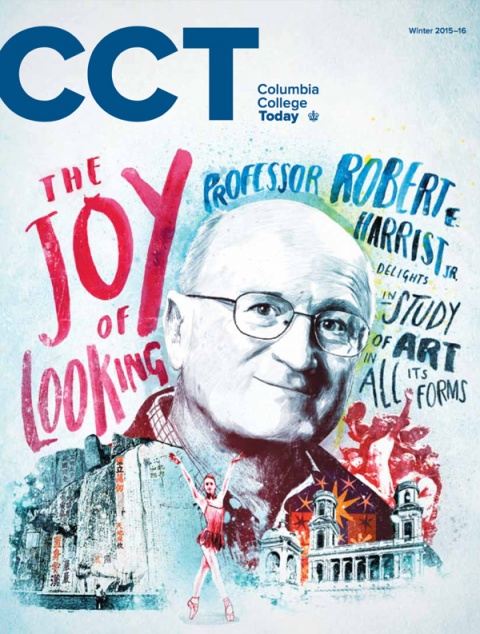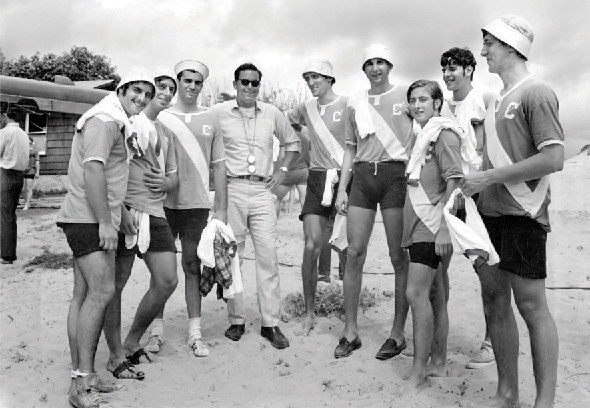Columbia College | Columbia University in the City of New York
Letters to the Editor
The Joy of Looking

Wonderful portrait of Professor Robert E. Harrist Jr. GSAS’81 (Winter 2015–16). He seems to embody the ideal College graduate, despite not having attended Columbia as an undergrad. Not only does his enthusiasm cross boundaries among art forms but he moves easily between Western and Eastern traditions.
When I was majoring in art history more than 30 years ago, I took a strong interest in traditional Chinese landscape painting. With no other options, I was forced to create my own independent study project on the topic under the tutelage of Richard Vinograd, Columbia’s Chinese art expert at the time. There was little dialogue between the Asian studies scholars and their Western counterparts.
I don’t know if it reflects a more open approach to cultural studies on the part of the University as a whole, or if it’s only Harrist’s idiosyncratic tastes, but this dual interest in our familiar Western canon with that of other cultures, particularly the Chinese, is timely and refreshing.
Mark Brennan ’82
Brooklyn, N.Y.
Feeling Adrift
In your Winter 2015–16 issue, Melissa Mark-Viverito ’91 states that she nearly abandoned Morningside Heights altogether, feeling adrift on a campus with few other Puerto Ricans and, she felt, with little support from the administration.
I was only one of two Ukrainian-Americans in my class, yet I did not feel “adrift.” There is more than one dimension to a human being. I enjoyed companionship and support from my fellow members in the Newman (Catholic) Club. Furthermore, I felt my primary goal at Columbia was to get a good education and to study hard — and not to dwell on my ethnic background or that of my fellow students. Most of my interactions with fellow Columbia students were positive and educational. I avoided the ones that were prejudiced.
Dr. Roman Kernitsky ’62
Colts Neck, N.J.
Postcrypt
Many sweet memories came to mind in reading that the Postcrypt in St. Paul’s Chapel is still going strong (“Around the Quads,” Winter 2015–16). Becoming quite the regular only a couple years after the Postcrypt opened, I vividly recall sitting by candlelight beside a classical guitarist playing Bach’s Bourrée in E-Minor and thinking, gosh, I wish I could do that! At the time, however, I was learning a somewhat different Bach on the Aeolian-Skinner pipe organ upstairs, which, amazingly, became my practice instrument after lessons. The Postscrypt below and its chapel above instilled a lifelong love of both coffeehouses and music, not to mention a passable rendition of that perky piece. I am truly glad that old storeroom still serves a cup and a note to the Columbia students of today.
Kurt J. Meyers ’70
Tucson, Ariz.
For Who/Whom the Bell Tolls
I enjoyed your article on my former WKCR colleague Michael Oren ’77, SIPA’78 (Winter 2015–16). But what’s this I see? A reference to “Oren’s children, whom he says are not right-wingers”? Whether this blunder was committed by author or editor or proofreader I know not, but whoever (whomever?) was responsible should be required to retake Freshman Seminar, or whatever they’re calling it these days.
Fred Kameny ’76
Chapel Hill, N.C.
(Editor's note: After a time as “Logic and Rhetoric,” that course is now called “University Writing.”)
All That Jazz
It was great to read the profile of Associate Professor of Music Chris Washburne GSAS’99 (“Around the Quads,” Winter 2015–16) and to hear about the dedication and enthusiasm he brings to the Department of Music and to the jazz program in particular. One of his comments, however, could bear a slight correction. He discusses founding the Louis Armstrong Jazz Performance Program because “having a university that abuts one of the most important neighborhoods in jazz history — Harlem — and not having an official jazz program was ridiculous.”
In fact, the College has had an official jazz program for more than 20 years. When I began my undergraduate studies in 1989, the College’s big band had only the status of a student activity; it was not formally associated with the Department of Music. I played in the big band for three years. During that period, I and several other band members, all College students, worked with the Department of Music in 1992 to secure official recognition for the big band, which became known as the Columbia University Jazz Orchestra. Most notably, from that point forward, big band members earned academic credit for their participation, at the same level as student classical musicians in the Columbia University Orchestra. Throughout that time, the big band was led by Don Sickler, a prominent jazz instrumentalist, arranger, publisher and educator. We played concerts with some of the world’s best jazz musicians as our guest artists. Some of the student musicians went on to highly successful music careers, including bassists Gary Wang ’95 and Michael Bitz ’94. The impressive and diverse jazz performance program that Columbia offers today, under Washburne’s direction, is a direct descendant of the groundwork we laid in the 1990s.
Jeremy Matz ’93
Los Angeles
Spring ’68
Readers interested in the Columbia events of Spring ’68 should be alerted to the fact that available on the CCT website is the illustrated, book-length essay “Six Weeks That Shook Morningside” by then-CCT editor George Keller ’51, GSAS’54, which filled the entire 96-page Spring 1968 issue. Having read many accounts of the campus protests of nearly 50 years ago, it’s worth pointing out that Keller’s essay is a vital piece of literature for anyone seeking to understand those complex times.
Since 2007 I have been working on A Time to Stir, a documentary film about those campus protests. Thus far more than 500 interviews have been filmed. Many boxes of documents and photographs have also been located and deposited into the Columbia University Archives, and I am working on a book for Columbia University Press on the subject. Both book and film will be ready for the 50th anniversary in 2018. Readers with memories or reminiscences of those days, and/or with material relating to the protests (including the years leading up to those heady days), please get in touch: pauljcronin@gmail.com or 646-757-0793.
Paul J. Cronin JRN’14
New York City
Double Discovery
As a counselor who served during the first summer of Double Discovery Center in 1965, I was pleased that this remarkable organization’s 50th anniversary was commemorated in the Fall 2015 issue (“Around the Quads”). The DDC is now reaching out to all of its past participants and asking students, counselors and administrators with a prior affiliation to register with DDC Executive Director Joseph Ayala ’94 at 212-854-3897 or ja48@columbia.edu. Thank you very much.
Jim Siegel ’65, BUS’68
New York City
Coach Bill Stowe
It was with great sadness that I learned of the passing of Bill Stowe, who died on February 8, 2016, after a fall at his home in Lake Placid, NY.

The Columbia heavyweight crews swept the Miami Intercollegiate Regatta in March 1969. Left to right: Tom Kinzler ’71; Mitch Brodey ’71; John Hughes ’71; head coach Bill Stowe; Dave Clark ’70; Bob Logan ’71; Andy Dunn (cox) ’71; Ken Heisler ’71, PS’75; and Bob Ropiak SEAS’72, BUS’74.
Stowe was the stroke oar of the legendary Vesper Boat Club eight that won the gold medal for the United States in rowing’s premier event in the 1964 Tokyo Olympics — a feat, incidentally, that would not be repeated for 40 years!
In fall 1967, Stowe was hired as head coach of Columbia rowing. He assembled a stellar staff, including Stan Bergman as freshman heavyweight coach (who became Penn’s head coach for 22 years) and Larry Gluckman, who succeeded Stowe as head coach when Stowe moved on to found the Coast Guard Academy’s rowing program in 1971.
Stowe was an inspiration to his Columbia oarsmen to the day he died. Not long ago one of them nominated him to the Columbia University Athletics Hall of Fame, writing, “Bill held the rowing program together — two full boats of heavyweights, every one of them a walk-on — through some of the darkest days of the University and did so with a modicum of success that would not be duplicated for many a year.”
Dr. Kenneth A. Heisler ’71, PS’75
Falmouth, Mass.
Addendum
Jonathan Yee SEAS’17, son of John Yee ’82, DM’87, transferred to Columbia in the fall but was omitted from the Fall 2015 issue’s “Alumni Sons and Daughters” listing on page 71.
Issue Contents
Published three times a year by Columbia College for alumni, students, faculty, parents and friends.
Columbia Alumni Center
622 W. 113th St., MC 4530, 6th Fl.
New York, NY 10025
212-851-7852
cct@columbia.edu
Columbia Alumni Center
622 W. 113th St., MC 4530, 4th Fl.
New York, NY 10025
212-851-7488
ccalumni@columbia.edu

